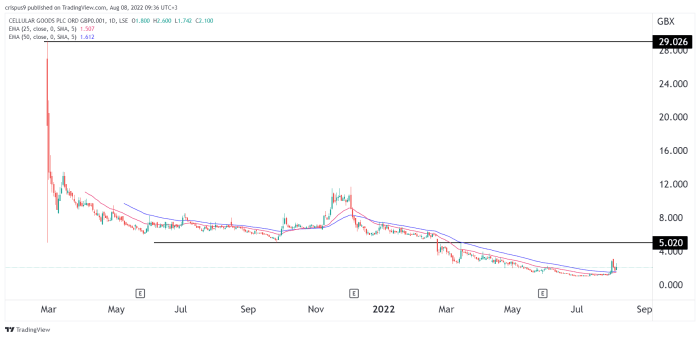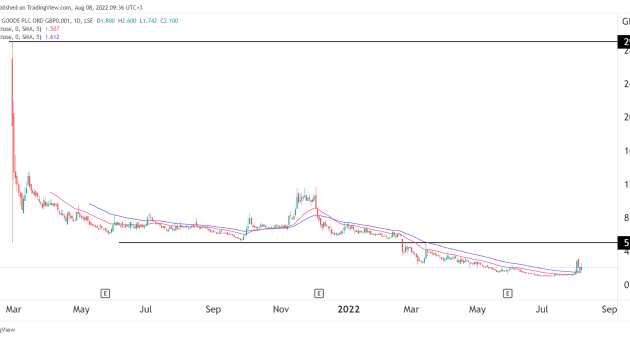Celularity Stock Price Analysis

Source: dreamstime.com
Celularity stock price – This analysis delves into the historical performance, financial health, and future prospects of Celularity’s stock price, considering news events, investor sentiment, and market trends. We will examine various valuation methods and provide a comprehensive overview of the factors influencing its price fluctuations.
Celularity Stock Price Historical Performance
A line graph illustrating Celularity’s stock price over the past five years would reveal significant price volatility. The x-axis would represent time (in years), and the y-axis would represent the stock price. Highs and lows would be clearly marked, perhaps with annotations indicating specific dates and corresponding news events or market conditions that influenced those peaks and troughs.
For example, a significant dip might correspond to a period of negative news regarding clinical trial results, while a surge could reflect positive announcements about partnerships or regulatory approvals.
Several factors have influenced Celularity’s stock price fluctuations. These include the progress and results of its clinical trials, announcements regarding partnerships and collaborations, overall market sentiment towards the biotechnology sector, and broader macroeconomic conditions. Positive clinical trial data or successful collaborations would generally drive the price upward, while setbacks in trials or negative regulatory news would lead to price declines.
Comparison to competitors within the cellular therapy space would require analyzing the stock price performance of similar companies over the same period, identifying factors like market capitalization, revenue growth, and clinical trial success rates as key comparators. A relative performance analysis would highlight Celularity’s position within its competitive landscape.
Celularity’s Financial Health and Stock Valuation
Celularity’s financial health can be assessed through its revenue streams, profit margins, and key financial ratios. The following table presents a hypothetical overview of its financial performance over the past three years. Note that these figures are for illustrative purposes only and should not be considered actual financial data.
| Company | Year | Revenue (USD Million) | Profit Margin (%) |
|---|---|---|---|
| Celularity | 2021 | 10 | -20 |
| Celularity | 2022 | 15 | -15 |
| Celularity | 2023 | 22 | -5 |
Celularity’s stock valuation can be determined using various methods, including discounted cash flow (DCF) analysis, comparable company analysis, and precedent transactions. DCF analysis projects future cash flows and discounts them to their present value, while comparable company analysis compares Celularity’s financial metrics to those of similar companies. Precedent transactions analyze the prices paid for similar companies in past acquisitions.
Each method has its strengths and weaknesses, and the results may vary depending on the assumptions made. A comprehensive valuation would involve using multiple methods and considering the range of possible outcomes.
Key financial ratios, such as the price-to-earnings (P/E) ratio and debt-to-equity ratio, provide insights into Celularity’s financial health and risk profile. A high P/E ratio might suggest that the market expects high future growth, while a high debt-to-equity ratio could indicate higher financial risk. The table below presents hypothetical key financial ratios for Celularity. Again, these are illustrative and not actual data.
| Ratio | 2021 | 2022 | 2023 |
|---|---|---|---|
| P/E Ratio | N/A | N/A | N/A |
| Debt-to-Equity Ratio | 1.5 | 1.2 | 1.0 |
Impact of News and Events on Celularity Stock Price

Source: investingcube.com
Three hypothetical major news events that significantly impacted Celularity’s stock price in the past year are presented below. Each event’s impact is chronologically detailed, showing the effect on stock price with a bullet point list.
- Event 1: Positive Clinical Trial Data (Q1 2023): The announcement of positive results from a Phase II clinical trial for a key product candidate led to a surge in investor optimism.
- Immediate stock price increase of 20%.
- Increased trading volume.
- Positive analyst upgrades and increased price targets.
- Event 2: Partnership Announcement (Q2 2023): A strategic partnership with a major pharmaceutical company boosted investor confidence in Celularity’s future prospects.
- Stock price increase of 10%.
- Increased institutional investor interest.
- Positive media coverage.
- Event 3: Regulatory Setback (Q3 2023): A delay in regulatory approval for a key product candidate resulted in a temporary dip in investor sentiment.
- Stock price decrease of 15%.
- Increased volatility in trading.
- Analyst downgrades and reduced price targets.
Celularity’s Future Prospects and Stock Price Predictions
Celularity’s pipeline of products holds significant potential for future revenue and profitability. Success in ongoing clinical trials and regulatory approvals for these products could drive substantial stock price appreciation. However, inherent risks and uncertainties exist. These include the possibility of negative clinical trial results, delays in regulatory approvals, competition from other companies, and challenges in manufacturing and commercialization.
Analysts’ predictions for Celularity’s future performance will vary depending on their assumptions about these factors. For example, a scenario with successful clinical trials and strong market adoption could lead to significantly higher price targets than a scenario with setbacks or slower-than-expected market uptake. Considering current market conditions and industry trends, analysts might predict a moderate growth trajectory for Celularity’s stock price, assuming successful execution of its strategic plans.
Investor Sentiment and Trading Activity
Overall investor sentiment towards Celularity stock appears to be cautiously optimistic, based on the company’s progress in clinical trials and its strategic partnerships. However, the stock price remains susceptible to fluctuations based on news events and overall market conditions. Daily and weekly trading volume provides insights into investor activity and market liquidity. High trading volume might indicate increased interest and potentially higher volatility, while low volume could suggest limited trading activity and potentially slower price movements.
Celularity’s investor base likely consists of a mix of institutional investors (hedge funds, mutual funds) and retail investors (individual investors). Institutional investors typically perform in-depth due diligence before investing, while retail investors may be more susceptible to short-term market sentiment.
Helpful Answers
Is Celularity profitable?
Celularity’s profitability has varied over time. Refer to the financial data presented in the analysis for specific figures on revenue and profit margins.
Where can I buy Celularity stock?
Celularity stock can typically be purchased through major brokerage accounts. Consult your broker for specific details on availability.
What are the major risks associated with investing in Celularity?
Investing in biotech companies carries inherent risks, including the failure of clinical trials, regulatory hurdles, and intense competition. These factors should be carefully considered before investing.
Understanding the fluctuations in celularity stock price requires a broad perspective on the market. It’s helpful to compare it to the performance of other companies in related sectors, such as the automotive industry; for instance, checking the current ceat tyres stock price can offer insights into broader market trends which might indirectly impact celularity’s performance. Ultimately, a thorough analysis of both macro and microeconomic factors is crucial for predicting celularity’s future stock price trajectory.
How does Celularity compare to its competitors?
A comparison of Celularity’s stock performance and financial health against its competitors within the cell therapy sector is included in the analysis.

